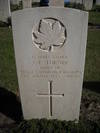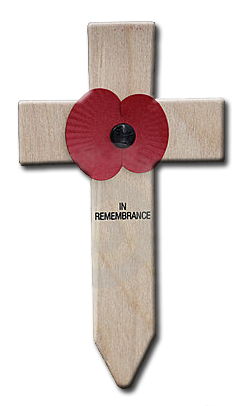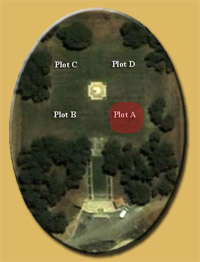










































In Memory of
TURNER, ALFRED FREDERICK, A F
Sapper, B/40325
Royal Canadian Engineers, R.C.I.C.
who died 25 age
06th August 1943
AGIRA WAR CEMETERY, SICILY

Son of Albert and Lilian Turner, of Hamilton, Ontario; husband of Renee Turner, of Hamilton.
Alfred Turner sailed to Sicily in the Slow Assault Convoy,
destined to land following the main assault with most of the unit's vehicles and equipment.
On the way, the ship. MV Devis, was torpedoed and sank.
Fifty-two Canadian soldiers were lost, including five from the 4th Field Company, Royal Canadian Engineers.
Alfred survived and was able to return with 11 others to his unit on 25 July while they were moving forward to Adrano.
Less than two weeks later after some of the most intense fighting of the Campaign,
Alfred had volunteered to go forward to do something dangerous,
perhaps disable land mines and he was struck by shrapnel during the crossing of the Simeno River.

Alfred's family had a strong military heritage and connections to the Royal Canadian Engineers (RCE). His father, Sgt Alfred George Turner enlisted in the Canadian Mounted Rifles during the First World War and served overseas in the 13th Battalion, Canadian Railway Troops in France and Belgium. Before enlisting in the Active Force in Hamilton on 31 March 1942, Alfred had been a Lance Corporal in the 1st Field Squadron, Non-Permanent Active Militia, RCE with two of his brothers since August 1940. Brother Sapper Cecil Turner had already enlisted in the Active Force and was overseas in RCE when Alfred enrolled. Brother Leading Aircraftsman Roy Turner, was also overseas in the Royal Canadian Air Force. Their oldest brother, Spr Albert Turner served in the RCE in Hamilton from 1940 until 1950.
Immediately upon enrollment, Alfred was sent to A5 Engineer Training Centre in Petawawa. As part of the training process, he was sent to the RCE Workshop in Toronto to verify his civilian bricklayer trade through a series of tests. He was successful and he was assigned the trade Bricklayer Class 'I' in April 1942. Alfred left Petawawa and embarked at Halifax on 14 June 1942, arriving in Greenock, Scotland on 25 Jun 1942 and taken on strength of the Canadian Engineer Reinforcement Centre (CERU) located at Guillemont Barracks in Hampshire in southern England. The CERU was organized into holding companies whose main task was completing individual training started in Canada before new arrivals were sent out to units. As well, the CERU sent troops on temporary assignments to various construction projects the RCE undertook in the early days of the war. Although there is no record in his personal file, it is likely that with Alfred's construction and military experience, he was involved in this type of work for a good deal of the time. Alfred spent over seven months at the CERU, during which time he was granted trades pay as a Bricklayer Group 'B' in October.
In February 1943, Alfred joined the 4th Field Company at a time of intensive training in Scotland focusing on amphibious operations with a series of challenging beach landing exercises. The concept of working closely with infantry troops became a focus and the 4th Field Company started its affiliation with the 3rd Canadian Infantry Brigade (3 CIB) which would last until the end of the war. Returning to southern England in March, training on bridging and mine warfare with a touch of rudimentary German language training occupied their time. In May, they returned to Scotland for mountain warfare training and mine clearance exercises with a focus on Italian, as well as German mines.
The total strength of Canadian units in the invasion fleet was over 26,000 officers and men with tanks, guns and enough supplies to sustain three weeks of fighting. The main invasion force would sail in two convoys with the combat units divided between the Fast Assault Convoy carrying the actual landing force and the Slow Assault Convoy carrying the follow-up troops. The Slow Assault Convoy would sail first and meet the Fast Assault Convoy off Malta on D minus 1. The Slow Assault Convoy left in two groups on 19 and 24 June 1943. Taking different sea routes for reasons and security and safety, they would meet near Algiers. It carried troops, equipment and supplies not needed for the initial assault. MV Devis was part of the Slow Assault Convoy that left while the landing exercises were still being carried out. Once at sea, the troops focused on physical training, washing, eating, fatigues, games and lectures emphasizing first aid, sanitation and the treatment of prisoners of war and civilians. On 1 July 1943, as theyneared the Strait of Gibraltar, Alfred and his comrades learned they were part of Montgomery's 8th Army and were headed to Sicily. With the announcement, a sealed bag containing detailed orders, maps, aerial photos, operations orders and intelligence pamphlets was opened on each ship along with a large-scale relief map and officers and men developed a solid vision of the topography upon which they would carry out their mission. This was in strict compliance with General Montgomery's direction that every soldier would go ashore physically fit and knowing what was required of him.
For the fast assault convoy, the passage was easy, but not so much for the slow convoy. While sailing off the coast of North Africa, it was attacked by submarines. On the night of 4 / 5 July, the MV St. Essylt and the MV City of Venice were torpedoed. The St. Essylt was abandoned in flames and the City of Venice sank while being towed to Algiers. Six Canadian soldiers were lost along with a significant amount of equipment and supplies. The next afternoon, MV Devis was also hit, just aft of amidships and just below the soldiers' mess deck.
When the torpedoes struck, many of the men were on the Mess Deck taking anti-malarial drugs. With the ship on fire, the ammunition stores exploded and separated the front from the back of the ship. The fire blocked the escape of anyone below decks. Amazingly, despite the fire, there was little panic and 257 men were able to abandon ship only when the order was given. The ship sank 20 minutes after being hit taking 52 Canadian soldiers and a considerable amount of equipment with it. Those not badly wounded in the attack were able to join their comrades in Sicily about a month later.
On 25 July, along with 11 others, Alfred rejoined the company in action as they were about to support 3 CIB as they moved forward protecting the flank of the British 78th Division advancing on the town of Adrano. Ten days later, after some of the most intense fighting the company had as until now experienced, came the last action of the Sicilian campaign - the crossing of the Simeto River. On the night of 5/6 August, the infantry made a successful crossing and seized their objective with no casualties. With several days of work ahead to provide a vehicle crossing, the company started working while they were still in range of enemy fire and observation. The situation was confused and it was not until two days later that the company's War Diary recorded that three sappers had been killed and two wounded that first night. Among the dead was Sapper Alfred Turner. He is buried in the Canadian War Cemetery in Agira.
Source: Engineers Association Canadian Miltary












